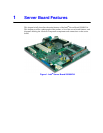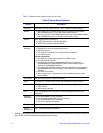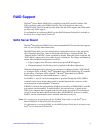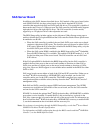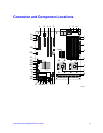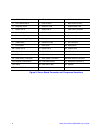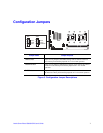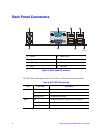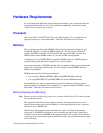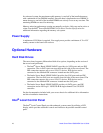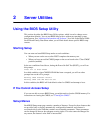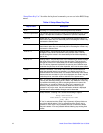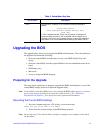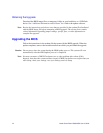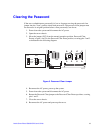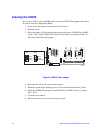Intel
®
Server Board S5000VSA User’s Guide 9
Hardware Requirements
To avoid integration difficulties and possible board damage, your system must meet the
requirements outlined below. For a list of qualified components, see the links under
"Additional Information and Software."
Processor
One or two Dual-Core Intel
®
Xeon
®
processor 5000 sequence. For a complete list of
supported processors, see the links under "Additional Information and Software."
Memory
The server board provides eight DIMM sockets across two channels, Channel A and
Channel B. Channel A consists of DIMM sockets A1, A2, A3, and A4. Channel B
consists of DIMM sockets B1, B2, B3, and B4. The entry SATA SKU provides four
DIMM sockets where DIMM sockets A3, A4, B3, and B4 are depopulated.
A minimum of one 512 MB DIMM is required in DIMM socket A1. DIMMs must be
installed starting with the lowest number slot in a given channel.
In non-mirrored mode, all DIMMs with the same slot number within a given branch must
match (size, technology, manufacturer). It is not required to match DIMMs between
different slot numbers.
DIMMs must meet the following requirements:
• Use only Fully Buffered DIMMs (FBD) with DDR2 DRAM technology.
• Use only FBD DDR2-533 and FBD DDR2-667 stacked DIMM modules.
In determining your memory requirements, the need for memory sparing or memory
mirroring must be considered. For a complete list of supported memory DIMMs, see the
links under "Additional Information and Software."
Memory Sparing and Mirroring
Note: Memory sparing and mirroring features are currently disabled and will be made available
after production launch.
The chipset includes hardware that supports memory mirroring and memory on-line
sparing. Both memory mirroring and memory on-line sparing provide a way to prevent
data loss in case a DIMM fails.
With memory mirroring the system maintains two copies of all data in the memory
subsystem. If a DIMM fails, the data is not lost because the second copy of the data is
available from the mirrored DIMM in the opposite channel. The system will not fail due
to memory error unless both the primary and the mirrored copy of the data become corrupt
at the same time.



